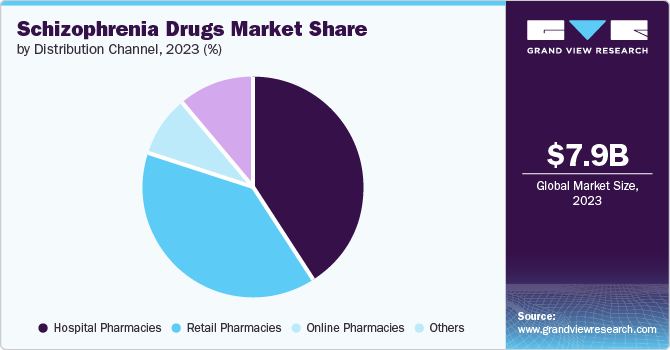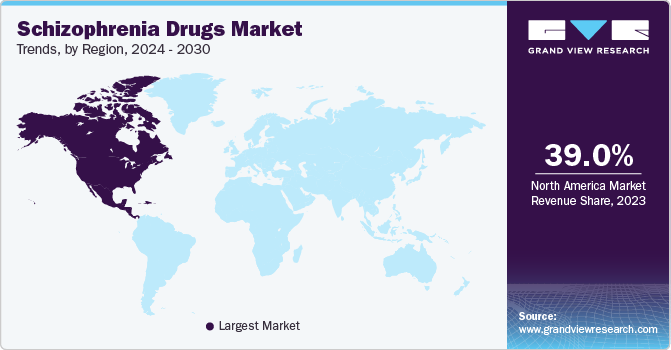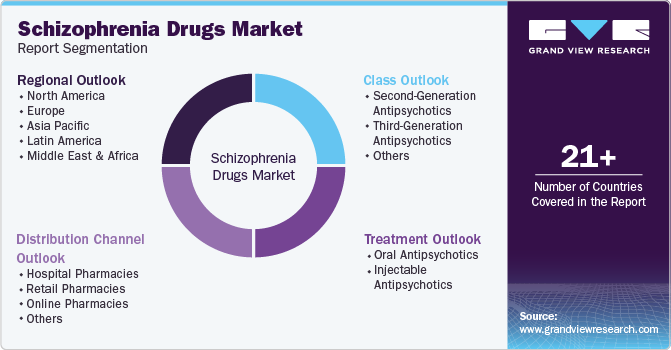
Schizophrenia Drugs Market Size, Share & Trends Analysis Report By Class (Second-Generation Antipsychotics, Third-Generation Antipsychotics, Others), By Treatment, By Distribution Channels, By Region, And Segment Forecasts, 2024 - 2030
- Report ID: GVR-2-68038-222-8
- Number of Report Pages: 100
- Format: PDF, Horizon Databook
- Historical Range: 2018 - 2022
- Forecast Period: 2024 - 2030
- Industry: Healthcare
Schizophrenia Drugs Market Size & Trends
The global schizophrenia drugs market size was valued at USD 7.90 billion in 2023 and is projected to grow at a CAGR of 5.3% from 2024 to 2030. The increasing demand is due to the rising prevalence of schizophrenia and other related mental health disorders worldwide. This increase can be attributed to genetic, environmental, and socio-economic factors. As awareness and diagnosis improve, more individuals are being identified with schizophrenia, thereby boosting the demand for effective treatment options.

Advancements in medical research and technology have led to the development of newer, more effective antipsychotic medications. These drugs often have fewer side effects and are more effective at managing the symptoms of schizophrenia, such as delusions, hallucinations, and cognitive impairments. It has increased the reliance on pharmaceutical interventions as a critical part of treatment plans, leading to higher demand for these medications.
Additionally, the increasing investment by governments and private organizations in mental health care has expanded access to treatment. More comprehensive healthcare coverage and mental health programs encourage people to seek medical help, leading to higher prescription rates for antipsychotic drugs. The stigma surrounding mental health disorders is also gradually decreasing, allowing more individuals to seek the treatment they need without fear of social repercussions. The aging population contributes to the growing demand for schizophrenia drugs. As the global population ages, the number of people at risk for mental health disorders, including schizophrenia, increases. This demographic shift necessitates a broader distribution and availability of medications to manage the condition effectively.
Class Insights
The second-generation-antipsychotics held the largest market revenue share of 73.0% in 2023. The demand for second-generation antipsychotics in the schizophrenia drugs market is rising due to their improved safety and efficacy profiles compared to first-generation antipsychotics. These newer drugs, also known as atypical antipsychotics, are associated with a lower risk of extrapyramidal symptoms, such as tremors and rigidity, which are common side effects of older medications. Additionally, second-generation antipsychotics are more effective in treating both the positive symptoms of schizophrenia, like hallucinations and delusions, and the negative symptoms, such as apathy and social withdrawal. These benefits, combined with better patient compliance and fewer severe side effects, have led to a growing preference for these medications among healthcare providers and patients.
The third-generation-antipsychotic segment is expected to grow at the fastest CAGR of 6.1% over the forecast period. The demand is projected to grow due to their superior clinical benefits over earlier drug classes. These medications, including agents like aripiprazole and brexpiprazole, offer more effective symptom control, particularly in reducing both the positive and negative symptoms of schizophrenia. They also present a lower risk of severe side effects, such as weight gain and movement disorders, which are common with first and second-generation antipsychotics. This improved safety profile enhances patient adherence and quality of life, making third-generation antipsychotics a preferred choice for long-term treatment. As healthcare providers and patients increasingly prioritize treatments with fewer side effects and better overall outcomes, the demand for these drugs is expected to continue rising.
Treatment Insights
The injectable antipsychotics treatment segment held the largest market revenue share in 2023. The demand for injectable antipsychotics is on the rise due to their ability to address several challenges associated with the condition. Injectable formulations, particularly long-acting injectables (LAIs), provide a steady release of medication, which helps maintain therapeutic drug levels and reduces the risk of relapse due to missed doses-a common issue with oral medications. This delivery method improves patient adherence and simplifies treatment regimens, as injections are needed less frequently than daily oral doses. Additionally, LAIs allow healthcare providers to monitor patient compliance and adjust treatment plans more effectively closely. The increasing awareness of these advantages, combined with advancements in injectable drug technologies, is significantly contributing to the growing preference for injectable antipsychotics in managing schizophrenia.
The oral antipsychotics treatment segment is expected to grow significantly over the forecast period. Oral antipsychotics are often preferred by patients and healthcare providers for their ease of administration and dosage flexibility, which enhances patient adherence to medication regimens. Introducing new oral formulations with improved safety and efficacy profiles also contributes to this trend. Moreover, the increasing awareness and diagnosis of schizophrenia, combined with the expansion of healthcare access in many regions, are driving the demand for these medications. Additionally, advancements in understanding the underlying mechanisms of schizophrenia have led to the development of oral antipsychotics targeting specific neurotransmitter pathways, offering more personalized and effective treatment options.
Distribution Channel Insights
The hospital pharmacies segment held the largest market revenue share in 2023. Hospital pharmacies are well-positioned to provide comprehensive care, including managing complex medication regimens and monitoring side effects, which are critical for this condition. Hospital pharmacies often have direct access to the latest drug formulations and clinical trial medications, making them a crucial distribution point for innovative therapies. Integrating hospital pharmacies with inpatient and outpatient services also ensures continuity of care, improving patient outcomes and adherence to prescribed treatments. This integrated approach is essential for managing chronic conditions like schizophrenia, where consistent and careful management of medications is essential.

The retail pharmacies segment is expected to grow at a significant CAGR over the forecast period. Retail pharmacies offer easy accessibility and convenience for patients seeking medication, which is crucial for managing chronic conditions like schizophrenia. With the growing prevalence of schizophrenia and the increasing awareness of mental health, more patients are seeking regular treatment, which retail pharmacies can readily provide. Retail pharmacies also offer personalized services, such as patient counseling and medication management, enhancing adherence to prescribed treatments. The trend towards integrating mental health services within community-based settings also supports the role of retail pharmacies as crucial access points for schizophrenia medications, further driving demand in this segment.
Regional Insights
North America schizophrenia drugs market held the largest market revenue share of 39.0% in 2023. It is attributable to the rising awareness and diagnosis rates of schizophrenia and related mental health disorders. Enhanced mental health screening and awareness campaigns have led to more individuals seeking treatment. Additionally, advancements in medical research have resulted in more effective and targeted therapies, encouraging greater adoption of these drugs. The aging population is also contributing, as schizophrenia symptoms often manifest in late adolescence or early adulthood, and older adults are increasingly seeking treatment for long-standing conditions. Furthermore, there is a growing emphasis on outpatient care and community-based treatment programs, which rely heavily on pharmaceutical management, thus driving the demand for these medications.

U.S. Schizophrenia Drugs Market Trends
The U.S. artificial intelligence market dominated the regional market in 2023. Schizophrenia is becoming increasingly recognized and diagnosed, partly due to improved mental health awareness and better diagnostic tools. This has led to more individuals being identified and treated for the condition. Advancements in pharmacological treatments have resulted in newer, more effective medications with fewer side effects, making them more appealing to patients and healthcare providers.
Europe Schizophrenia Drugs Market Trends
Europe schizophrenia drugs market has been experiencing a significant growth rate. There is a growing awareness and destigmatization of mental health issues, leading more individuals to seek treatment. Governments and healthcare systems across Europe are also investing in mental health services, improving access to care and medication. Furthermore, advancements in pharmaceutical research have led to the development of more effective and better-tolerated medications, encouraging adherence and long-term treatment, thereby boosting demand.
The UK schizophrenia drugs market is expected to grow rapidly in the coming years. The UK government's initiatives to prioritize mental health, such as the NHS Long Term Plan, have significantly improved access to mental health services, leading to earlier diagnosis and treatment of schizophrenia. Moreover, the introduction of newer, more effective antipsychotic medications has made treatment more accessible, contributing to the growing demand.
Asia Pacific Schizophrenia Drugs Market Trends
Asia Pacific schizophrenia drugs market is expected to grow at the fastest CAGR over the forecast period. In the Asia-Pacific region, the increasing demand for schizophrenia drugs is influenced by specific regional developments. In China, the government's healthcare reforms have improved access to mental health services, leading to a rise in diagnosed cases and, consequently, the need for medications. Japan's aging population faces higher incidences of schizophrenia, particularly among older people, requiring sustained pharmaceutical intervention. Additionally, countries like Australia and South Korea are making strides in reducing the stigma around mental health and integrating mental health services into primary care, which improves access to necessary treatments.
China schizophrenia drugs market is expected to grow significantly in the coming years. The significant increase in diagnosed cases is partly driven by improved healthcare infrastructure and awareness campaigns by the Chinese government. Additionally, China's rapid urbanization and economic growth have led to lifestyle changes and increased stress levels, contributing to the prevalence of mental health disorders, including schizophrenia. Moreover, China's aging population is experiencing a rise in age-related mental health issues, including schizophrenia, necessitating greater access to medications.
Key Schizophrenia Drugs Company Insights
Some of the key companies in the schizophrenia drugs market include:
-
Johnson & Johnson, through its subsidiary Janssen Pharmaceuticals, is a significant player in the schizophrenia drugs market. The company offers a range of antipsychotic medications designed to treat schizophrenia, including long-acting injectables like Invega Sustenna (paliperidone palmitate) and oral medications such as Risperdal (risperidone). These products are known for their efficacy in managing symptoms of schizophrenia, providing both immediate and sustained-release formulations to cater to the diverse needs of patients.
-
Pfizer is a pharmaceutical company known for its research and development of innovative therapies across various medical fields, including mental health. Pfizer offers Geodon (ziprasidone), an atypical antipsychotic medication used to treat symptoms of schizophrenia and bipolar disorder. Pfizer's involvement in the schizophrenia drugs market reflects its commitment to advancing mental health treatment through the development of effective and accessible medications.
Key Schizophrenia Drugs Companies:
The following are the leading companies in the schizophrenia drugs market. These companies collectively hold the largest market share and dictate industry trends.
- Johnson & Johnson
- Bristol-Myers Squibb/ Otsuka Pharma
- AstraZeneca
- Sumitomo Dainippon
- Eli Lilly & Company
- Alkermes
- Vanda Pharma
- Allergan
- Pfizer
- H. Lundbeck A/S
Recent Developments
-
In October 2021, Alkermes announced the launch of Lybalvi, an antipsychotic medication for adults with schizophrenia and bipolar I disorder. Lybalvi combines olanzapine, an established antipsychotic, with samidorphan, a new compound, to treat these conditions. The medication aims to offer an effective treatment option with a lower risk of weight gain, a common side effect of antipsychotics.
Schizophrenia Drugs Market Report Scope
|
Report Attribute |
Details |
|
Market size value in 2024 |
USD 8.19 billion |
|
Revenue forecast in 2030 |
USD 11.20 billion |
|
Growth Rate |
CAGR of 5.3% from 2024 to 2030 |
|
Base year for estimation |
2023 |
|
Historical data |
2018 - 2022 |
|
Forecast period |
2024 - 2030 |
|
Report updated |
September 2024 |
|
Quantitative units |
Revenue in USD million and CAGR from 2024 to 2030 |
|
Report coverage |
Revenue forecast, company ranking, competitive landscape, growth factors, and trends |
|
Segments covered |
Class, treatment, distribution channel, region |
|
Regional scope |
North America; Europe; Asia Pacific; Latin America; MEA |
|
Country scope |
U.S.; Canada; Mexico; Germany; UK; France; Spain; Italy; Denmark; Sweden; Norway; China; Japan; India; South Korea; Thailand; Australia; Brazil; Argentina; UAE; South Africa; Saudi Arabia; Kuwait |
|
Key Companies Profile |
Johnson & Johnson; Bristol-Myers Squibb/ Otsuka Pharma; AstraZeneca; Sumitomo Dainippon; Eli Lilly & Company; Alkermes; Vanda Pharma; Allergan; Pfizer; H. Lundbeck A/S |
|
Customization scope |
Free report customization (equivalent up to 8 analysts working days) with purchase. Addition or alteration to country, regional & segment scope. |
|
Pricing and purchase options |
Avail customized purchase options to meet your exact research needs. Explore purchase options |
Global Schizophrenia Drugs Market Report Segmentation
This report forecasts revenue growth at global, regional, and country levels and provides an analysis of the latest industry trends in each of the sub-segments from 2018 to 2030. For this study, Grand View Research has segmented the global schizophrenia drugs market report based on class, treatment, distribution channel, and region:

-
Class Outlook (Revenue, USD Million, 2018 - 2030)
-
Second-Generation Antipsychotics
-
Risperdal (Risperidone)
-
Invega (Paliperidone)
-
Zyprexa (Olanzapine)
-
Geodon (Ziprasidone)
-
Seroquel (Quetiapine)
-
Latuda (Lurasidone)
-
Aristada (Aripiprazole Lauroxil)
-
Fanapt (Iloperidone)
-
Saphris (Asenapine)
-
Vraylar (Cariprazine)
-
-
Third-Generation Antipsychotics
-
Abilify (Aripiprazole)
-
-
Others
-
First-Generation Antipsychotics
-
Generics
-
-
-
Treatment Outlook (Revenue, USD Million, 2018 - 2030)
-
Oral Antipsychotics
-
Injectable Antipsychotics
-
-
Distribution Channel Outlook (Revenue, USD Million, 2018 - 2030)
-
Hospital Pharmacies
-
Retail Pharmacies
-
Online Pharmacies
-
Others
-
-
Regional Outlook (Revenue, USD Million, 2018 - 2030)
-
North America
-
U.S.
-
Canada
-
Mexico
-
-
Europe
-
Germany
-
UK
-
France
-
Spain
-
Italy
-
Sweden
-
Denmark
-
Norway
-
-
Asia Pacific
-
China
-
Japan
-
India
-
South Korea
-
Australia
-
Thailand
-
-
Latin America
-
Brazil
-
Argentina
-
-
Middle East and Africa (MEA)
-
Saudi Arabia
-
UAE
-
Kuwait
-
South Africa
-
-
We are committed towards customer satisfaction, and quality service.
"The quality of research they have done for us has been excellent."




